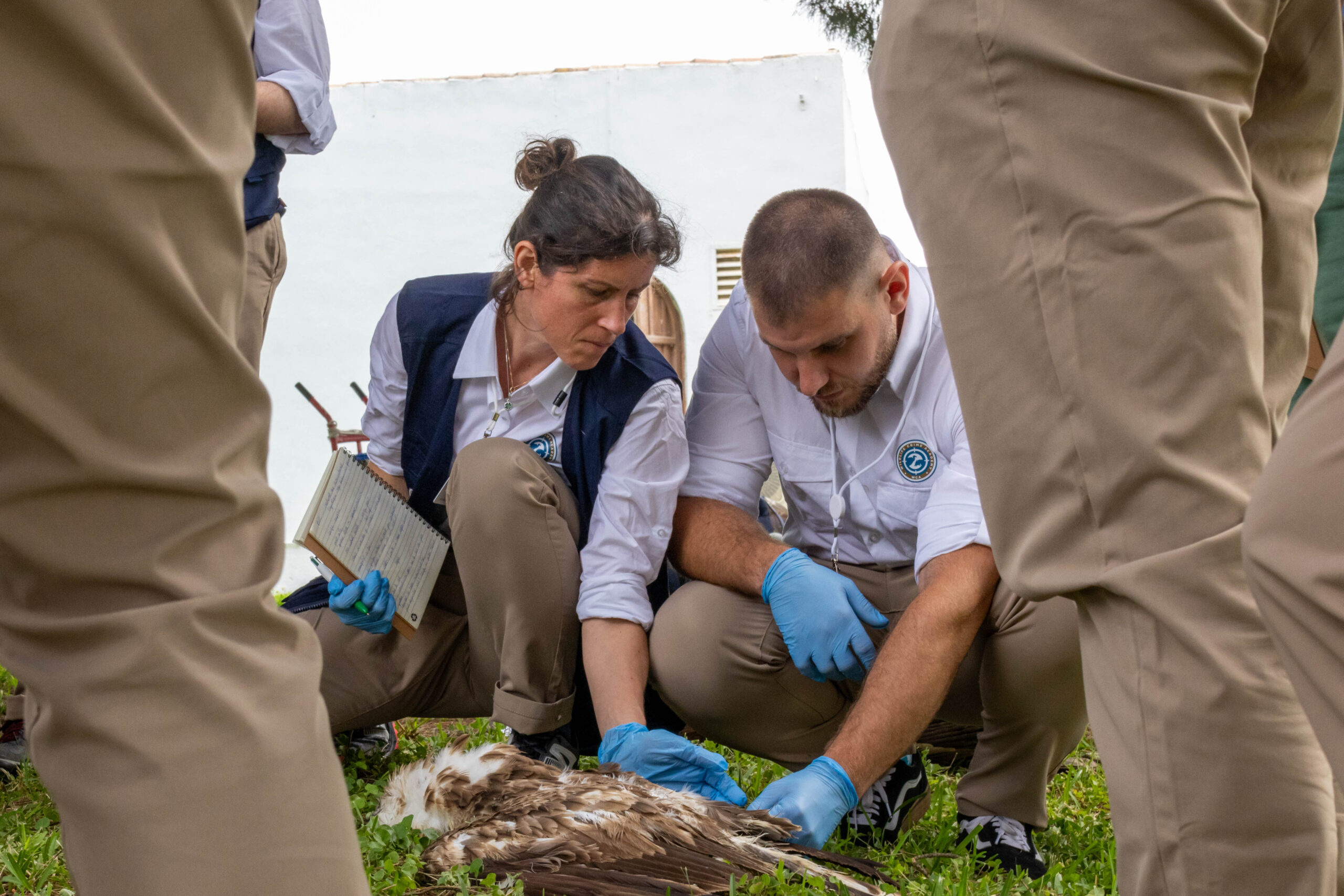
Discovering Bessie’s carcass
On 24 November, a hunter discovered the body of Bessie under power lines in the municipality of Tolbaños de Arriba (Burgos), which is part of the area where GREFA is working for the recovery of the Cinereous Vulture with the Proyecto Monachus in the Sierra de la Demanda. A GREFA technician immediately went to the scene and realised that it was ‘Bessie’, who had been missing since 24 September.
Bessie
Bessie hatched in 2016 and was admitted to the Burgos Wild Animal Recovery Centre (CRAS) from La Vid (Burgos) where she was found malnourished and weak. At the end of 2017, she was transferred to the Cinereous Vulture acclimatisation aviary of Proyecto Monachus located in the reintroduction area of Huerta de Arriba. In autumn 2018, Bessie was released, and in January 2019, she was paired with ‘Arpín’, another Cinereous Vulture released by the project.
Taking action to prevent collision

After the discovery of the carcass and its removal by environmental agents, GREFA notified the electricity company Iberdrola that their powerlines killed Bessie, urging for their immediate action. Two weeks later, the company secured the power lines with anti-electrocution and anti-collision measures. GREFA notified electricity companies of the area to secure powerlines, and hopefully, the respective companies will take the actions necessary to reduce the risk of collision and electrocution.
An exceptional couple
As in other similar cases, GREFA already suspected that Bessie was dead since she was a female Cinereous Vultures paired to defend a territory, a vital situation in which an individual does not tend to separate from and abandon its partner and its territory.
This couple was the most attentive, affectionate and territorial of all the Cinereous Vultures of the project. They did not separate from each other, had continuous signs of affection and were very aggressive with other vultures.
Arpín didn’t even wait two weeks before he found another partner, Bioco, who was Bessie’s companion in the aviary. Thankfully, there is a chance that Arpín and Bioco will breed by 2020.

Threats to vultures caused by energy infrastructure
The Vulture Multi-species Action Plan (Vulture MsAP), co-developed by us here at the Vulture Conservation Foundation, and endorsed by the Convention for Migratory Species (CMS), identified the often overlooked threat to vultures posed by energy infrastructure particularly electrocution and collisions. Collision with energy infrastructure occurs when vultures are unable to distinguish the power line or wind turbine against the background of the natural vegetation as they fly near them.
Mitigating the threat of collisions
Collision with power lines occurs when vultures are unable to distinguish the powerline against the background of the natural vegetation as they use them to navigate or fly near them. The deaths from these threats are sadly underreported, for example, in Spain only 10% of the mortality caused by collision is recorded.
The Vulture Conservation Foundation (VCF) is involved in different project to mitigate the threat of collision. There are many projects, including our own LIFE-funded projects such as LIFE Rupis, Vultures Back to LIFE, LIFE GYPHELP and LIFE Re-Vultures, that are working to protect vultures from the risks posed by the electricity infrastructure by adding high visibility reflectors and spirals to cables to help improve the visibility of power lines which reduces the risk of collision with power cables. The MAVA Foundation is also funding projects across the eastern Mediterranean flyway to minimise the danger of electrocution and collision.
Mortality database
In 2017, the VCF started a new three-year venture with the MAVA Foundation in collaboration with BirdLife, IUCN, WWF and EuroNatur in order to “document vulture population’s demography and trends – baseline data, causes of mortality and indicators towards the priority species outcome”. This project aims to widen the knowledge on the 4 European vulture species through specific monitoring programmes, as well as to gather already existing information from several sources. In addition to other actions, the project includes the establishment of a European database on mortality data for the four vulture species in Europe and the Mediterranean basin. This will be used as a tool of easy access and usage, which will give us a better overview of local and temporal threats and the real situation of European populations, which will, in turn, help us carry out more accurate conservation actions.



